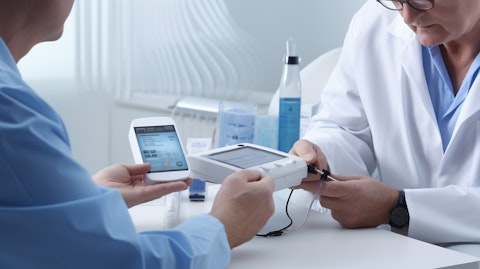We recently compiled a list of the 7 Best Diabetes Stocks To Buy Now. In this article, we are going to take a look at where DexCom, Inc. (NASDAQ:DXCM) stands against the other diabetes stocks.
According to the WHO, approximately 422 million individuals globally suffer from diabetes, with the majority residing in countries with low or middle incomes. Diabetes is directly responsible for an average of 1.5 million fatalities annually. Over the past few decades, there has been a steady rise in both the number of cases and the prevalence of diabetes. On the other hand, the International Diabetes Federation estimates that there are about 500 million diabetics worldwide, and that figure is projected to grow by 25% by 2030 and by 51% by 2045.
To help manage diabetes, both type 1 and type 2, one particular kind of medical device used is the continuous glucose monitor (CGM). The market has grown dramatically in recent years, and it has become a rapidly expanding section of diabetes care devices. The market for advanced diabetes care products — insulin pumps, pens, and continuous glucose monitoring (CGM) equipment, was estimated to be worth $21.8 billion in 2023 per GlobalData. Forecasts from GlobalData indicate that the market will reach revenues of $33.4 billion by 2030, rising at a CAGR of 6.34% over the forecast period.
As per the GlobalData marketed products database, the CGM category presently has 97 products. The vast majority of these devices are traditional CGMs, with only a few implantable sensors. According to the GlobalData pipeline products database, 133 products are either under development or approved. The figures show that this market segment is expanding quickly and is a hub for innovative new technology like implantable CGMs.
Today, CGM technology is also integrating AI. For example, Roche recently introduced new predictive AI-powered CGM technology (Accu-Chek SmartGuide). During the unveiling, Chief Medical Officer Julien Boisdron of Roche Diabetes Care referred to it as “a solution more than a CGM.” He described how the solution, which consists of two programs and a sensor, aids in both data visualization and prediction.
A new era of possibility has dawned in diabetes management and its associated complications. These novel techniques present significant opportunities for treating the combined problems associated with diabetes and obesity. A class of drugs called glucagon-like peptide-1 (GLP-1) agonists is used to treat obesity and type 2 diabetic mellitus (T2DM). As mentioned in our article, “10 Best GLP-1 and Weight Loss Stocks to Buy Now,” by 2030, the GLP-1 market, driven equally by obesity and diabetes, is expected to reach $100 billion. Thirty million GLP-1 users, or around 9% of the US population, may be on the medication by 2030.
The latest KFF Health Tracking survey indicates that 12% of American adults claim to have used a GLP-1 medicine at some point. Over the last half-decade, patients with diabetes now account for 43% of GLP-1 prescription users, while 22% of patients with obesity or overweight diagnoses also take the treatment. Adults who have heard “a little” or “a lot” about these drugs have gone from 70% to 82% over the past year, while those who have heard “a lot” or “a lot” about them have increased from 19% to 32%.
However, there are now difficulties as a result of the increased demand for these diabetes and weight reduction medications. A potential “explosion in the unlicensed sale of medication online” was indicated by the National Pharmacy Association (NPA). Semaglutides under the brand name Ozempic help individuals with type 2 diabetes control their blood sugar levels, but in some countries, such as the US under the brand name Wegovy, they are also widely used to help patients lose weight.
NPA chairman Nick Kaye stated:
“Pharmacists remain deeply concerned that the current medicine shortages crisis could lead to an explosion in the unlicensed sale of medication online.”
Methodology:
We sifted through holdings of ETFs exposed to the diabetes care industry and financial media to form an initial list of 20 diabetes stocks. Then we selected the 7 stocks that had the highest upside potential and market caps above $2 billion. The stocks are ranked in ascending order of the upside potential.
Why are we interested in the stocks that hedge funds pile into? The reason is simple: our research has shown that we can outperform the market by imitating the top stock picks of the best hedge funds. Our quarterly newsletter’s strategy selects 14 small-cap and large-cap stocks every quarter and has returned 275% since May 2014, beating its benchmark by 150 percentage points. (see more details here)

A doctor demonstrating how to use the medical device to a patient with diabetes.
DexCom, Inc. (NASDAQ:DXCM)
Analysts’ Upside Potential: 51.58%
The goal of the medical device firm DexCom, Inc. (NASDAQ:DXCM) is to design, develop, and market continuous glucose monitoring (CGM) devices both domestically and abroad. The company sells its systems to healthcare professionals and individuals with diabetes.
The US Food and Drug Administration approved Dexcom’s latest over-the-counter CGM, Stelo, for use in March, the company reported. Patients with Type 2 diabetes who do not take insulin are intended to use Stelo.
On July 26, Dexcom, Inc. (NASDAQ:DXCM) saw its worst-ever decline as its shares fell more than 40% to finish at $64, wiping out more than $17 billion in market capitalization. The sharp drop followed the company’s release of less optimistic second-quarter earnings and expectations for the balance of the year. This was the worst one-day decline since September 2017, when the stock dropped 33% in a single day.
The diabetes treatment company, well-known for its continuous glucose monitors (CGMs), witnessed a 15% YoY increase in revenue in Q2 2024 to $1 billion. However, the total revenue was less than analysts’ projections of $1.04 billion. The main source of worry for investors was Dexcom’s updated revenue projection, which was previously expected to be between $4.20 billion and $4.35 billion. Instead, the company now projects revenue for the third quarter of $975 million to $1 billion and $4 billion to $4.05 billion for the entire year.
CEO Kevin Sayer blamed the losses on a poor reorganization of the sales force, fewer new clients than projected, and a decline in revenue per user. The company also encountered difficulties with the G7 CGM’s rebate structure and its durable medical equipment (DME) channel.
JPMorgan reduced its rating on Dexcom’s shares from buy to hold, noting the company’s “sharp turn in the wrong direction” and raising doubts about whether internal problems were more likely to be the cause than outside variables like the growing popularity of GLP-1 weight loss medications. Despite the turbulence, analysts at Leerink and William Blair are optimistic about the company’s long-term prospects since they think the present problems are temporary and won’t likely affect its trajectory for its future growth.
Baron Health Care Fund stated the following regarding DexCom, Inc. (NASDAQ:DXCM) in its Q2 2024 investor letter:
“DexCom, Inc. (NASDAQ:DXCM) sells a continuous glucose monitoring device to help diabetics monitor their blood glucose levels. Investors reacted negatively to DexCom’s first quarter earnings report, which missed revenue estimates. In addition, year-over-year comparisons will be even tougher to beat in the yet-to-be-reported second quarter, and some investors appeared to interpret management commentary as trying to manage expectations due to the tougher comparisons and potential disruption from an increase in the sales force and reconfiguration of sales territories. We think these concerns are shortsighted and believe DexCom has a long runway for growth driven by increased adoption of its continuous glucose monitoring sensors. We are also optimistic about the launch of Stelo, an over-the-counter glucose sensor for Type 2 diabetics who are not on insulin.”
It is one of the best diabetes stocks to buy now since 17 analysts have given an average price target of $107.65 and an upside potential of 51.58% from the current stock price of $71.02. Analysts have rated DXCM as a “buy.”
Overall DXCM ranks 2nd on our list of the best diabetes stocks to buy. While we acknowledge the potential of DXCM as an investment, our conviction lies in the belief that some AI stocks hold greater promise for delivering higher returns and doing so within a shorter time frame. If you are looking for an AI stock that is more promising than DXCM but that trades at less than 5 times its earnings, check out our report about the cheapest AI stock.
READ NEXT: $30 Trillion Opportunity: 15 Best Humanoid Robot Stocks to Buy According to Morgan Stanley and Jim Cramer Says NVIDIA ‘Has Become A Wasteland’.
Disclosure: None. This article is originally published at Insider Monkey.





